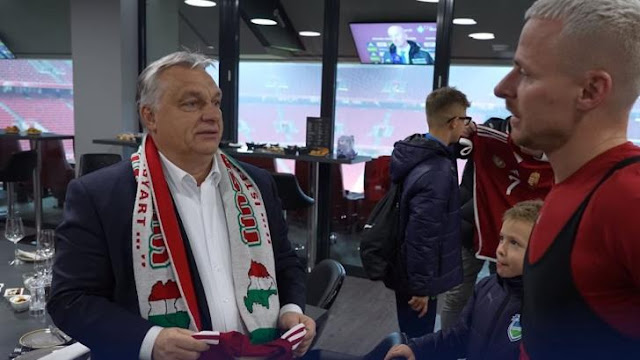Filenews 5 December 2022
By Andreas Kluth
Sometimes a cigar is just a cigar, as conscious Freudians like to self-deprecate. And sometimes, a scarf is just a scarf, especially when one wears it to support one's country in a football match.
But when the wearer happens to be Hungarian Prime Minister Viktor Orban - and the scarf in question depicts a map of 'Greater Hungary', which denotes territorial claims to neighbouring countries - there is a problem.
Putin's far-right and "best friend"
Orban is a far-right populist who has been in power - in his current term - since 2010. During this time, it has systematically undermined the rule of law, democratic norms, political institutions and relations with the European Union.
He is also "sticky" with Vladimir Putin, despite the genocidal imperialism of the Russian president. It is a model for aspiring authoritarian leaders across the West. As for the maps of Greater Hungary, they are an integral part of his ultra-nationalist style.
These maps continue to appear wherever Orban and his minions appear - the representative of the Hungarian government has, for example, a huge one on the wall behind his desk. These depict the lands of the Hungarian crown as they formed within the Austro-Hungarian Empire and up to the Treaty of Trianon, signed in 1920 as part of the Paris Peace Conference, which ended World War I.
Hard
The treaty, admittedly, was harsh on the Hungarians. The new nation had to cede about two-thirds of its territory and population to other states. It renounced particularly large parts of territory which today belong to Ukraine, Romania, Slovakia, Serbia, Croatia and Austria.
On the other hand, Hungarians are no different in this respect from most Europeans. However, one does not see, say, the German Chancellor appearing at football matches "wrapped" in maps in which Germany stretches from Koenigsberg (Russian Kaliningrad) to Silesia (Poland), South Jutland/Northern Schleswig (Denmark) and Alsace (France). And we thank God for that.
There is an important reason why most Europeans do not play with the fire of irredentism. The whole point of European integration after the Second World War was to move forward in relation to the dark ages in which Europeans continued incessantly to kill each other beyond their borders - and to fight for a way of coexistence and cooperation in which borders would no longer be of great importance to people living on either side of them, precisely because Europeans would now be free.
Invisible
One of the best examples is Alsace. For centuries, France and Germany fought for it. Today the place is fortunately French, but also essentially European, a prosperous part of a tri-ethnic region where people live, love, work and move as they please. The "lesson of Alsace" is: don't question borders, just make the minutes invisible. The EU requires all members and all candidate countries to accept this condition. Hungary did so, in theory, when he joined the club in 2004.
What makes Orban's paleo-nationalism so worrying is that it deliberately leads to a trend in the opposite direction, back to the bad old days of irredentism. And it is a real trend.
The Balkan nations emerging from the former Yugoslavia have for the time being stopped fighting each other, yet the Serbs are still playing their ethno-chauvinist games in Kosovo and - indirectly - in Bosnia and Herzegovina. In the Aegean, Turkish President Recep Tayyip Erdogan is threatening that his troops may "suddenly come one night" to seize Greek islands.
Beyond that, of course, there is Putin, this self-proclaimed "collector of Russian lands." He also had old and outdated maps in mind when he attacked Ukraine and began to destroy it. Ukrainians - who lived for centuries under the Lithuanians, Poles, Habsburgs, Tsars, Germans and Soviets - recognise that this is an imperialist scenario and resist heroically.
European spirit
Just because they are busy repelling the Russian invaders in the south and east, does not mean that the Ukrainians were "amused" exactly with Orban's scarf and the map which shows areas of western Ukraine to be Hungarian. Kiev called the Hungarian ambassador and gave him a hand. Hungary's neighbours within the EU were also not at all happy. Romania expressed its "firm disapproval".
Slovakia's Prime Minister, Eduard Heger, opted for a costume response. "I noticed that Viktor Orban has an old scarf," he said expressionlessly. "So I offered him a new one."
It turned out to be a Slovak fan scarf. Heger carried the scarf around him and around Orban, and the duo posed for a reconciliation selfie.
That, in fact, is the European spirit. Hopefully, Orban understands this.
Source:BloombergOpinion
